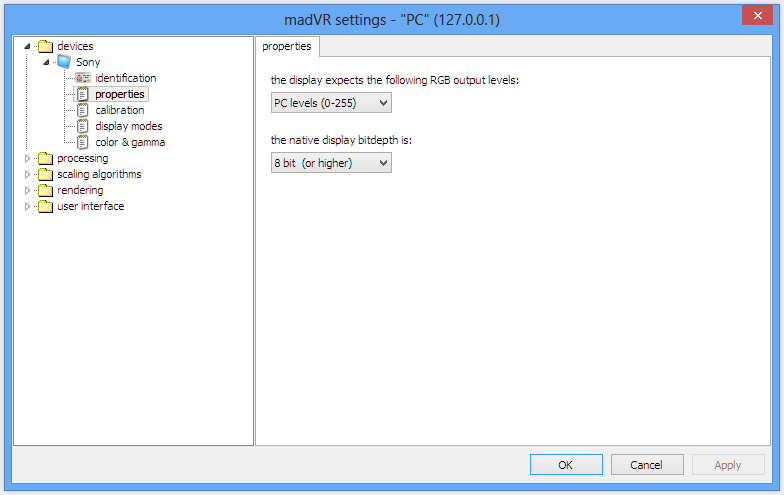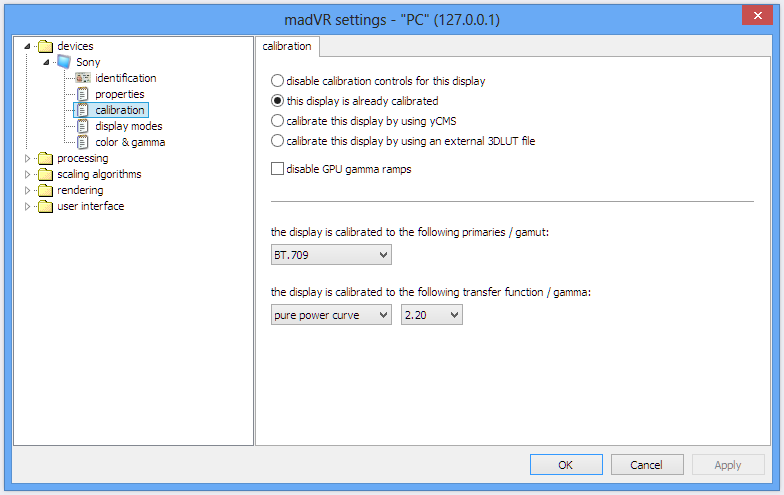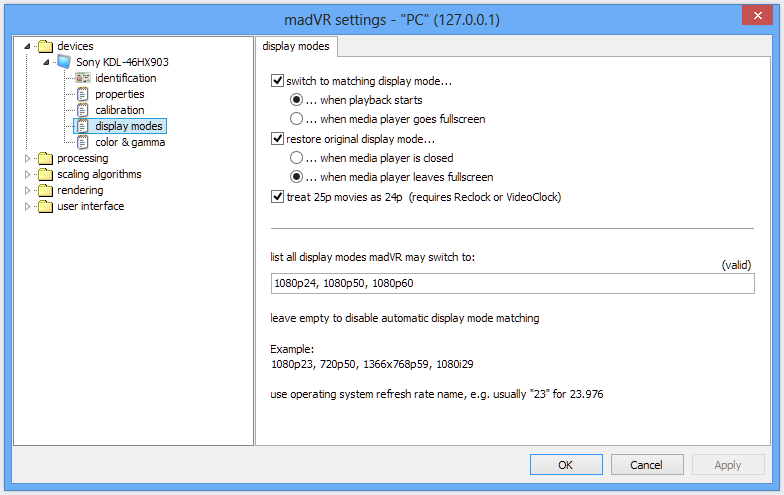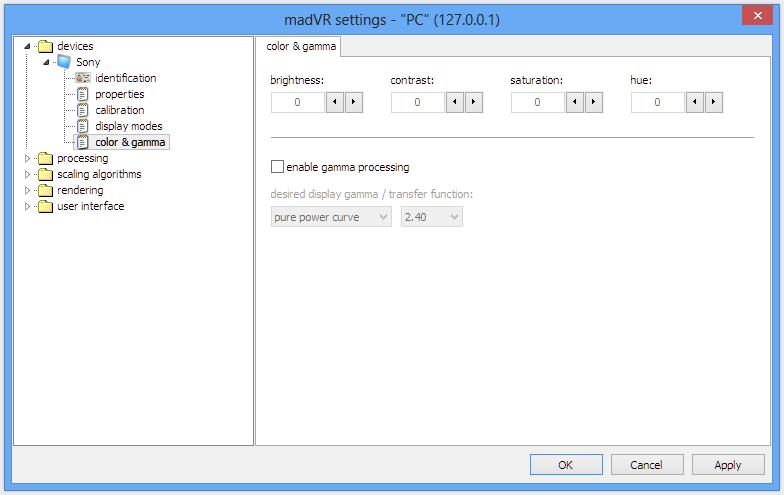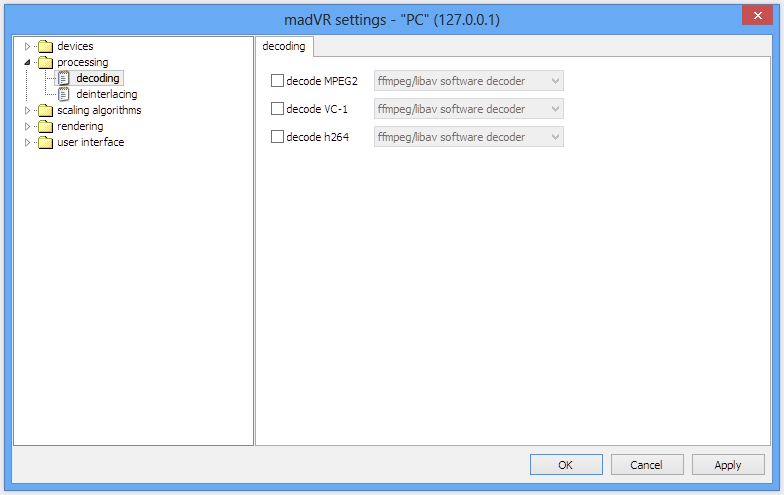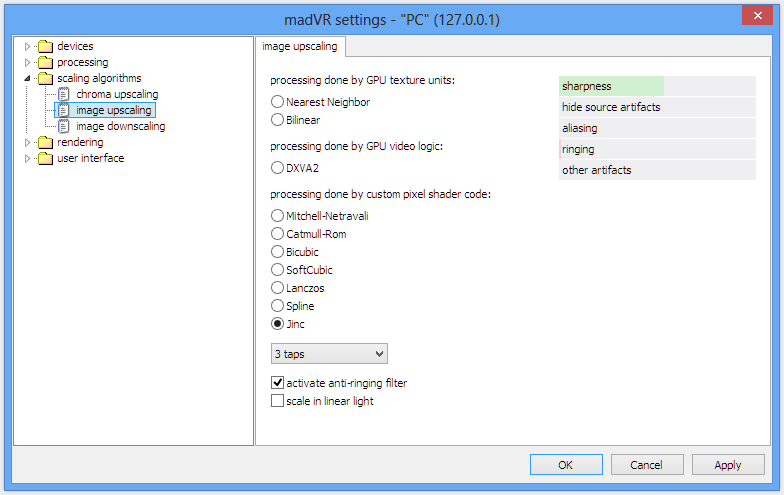InflatableMouse-temp: Difference between revisions
No edit summary |
No edit summary |
||
| Line 46: | Line 46: | ||
And unless you specifically know that your display is using less than 8-bit natively, you should leave that option at 8-bit. Reducing it increases the amount of dithering (noise) madVR will add to the image. |
And unless you specifically know that your display is using less than 8-bit natively, you should leave that option at 8-bit. Reducing it increases the amount of dithering (noise) madVR will add to the image. |
||
==Calibration== |
===Calibration=== |
||
[[File:03-calibrationoluk8.png|none|frame|Calibration tab in MadVR Settings]] |
[[File:03-calibrationoluk8.png|none|frame|Calibration tab in MadVR Settings]] |
||
| Line 57: | Line 57: | ||
The yCMS and 3DLUT options are a lot more complicated to use, and are also more demanding of your GPU. |
The yCMS and 3DLUT options are a lot more complicated to use, and are also more demanding of your GPU. |
||
==Display Modes== |
===Display Modes=== |
||
[[File:Refresh-rates1oj0c.png|none|frame|Display Modes tab in MadVR Settings]] |
[[File:Refresh-rates1oj0c.png|none|frame|Display Modes tab in MadVR Settings]] |
||
| Line 72: | Line 72: | ||
<span style="color: blue;"><b><i>Updated 13/06/2013:</i></b></span> There is an issue with Windows 8 where most video cards will switch to 23Hz and 59Hz when an application tries to set the refresh rate to 24Hz or 60Hz. madVR 0.86.3 fixes this problem. Media Center's switcher currently does not, and will switch to 23/59Hz rather than 24/60Hz as specified. |
<span style="color: blue;"><b><i>Updated 13/06/2013:</i></b></span> There is an issue with Windows 8 where most video cards will switch to 23Hz and 59Hz when an application tries to set the refresh rate to 24Hz or 60Hz. madVR 0.86.3 fixes this problem. Media Center's switcher currently does not, and will switch to 23/59Hz rather than 24/60Hz as specified. |
||
==Color & Gamma== |
===Color & Gamma=== |
||
[[File:05-color-gammatcusb.png|none|frame|Color & Gamma tab in MadVR Settings]] |
[[File:05-color-gammatcusb.png|none|frame|Color & Gamma tab in MadVR Settings]] |
||
| Line 79: | Line 79: | ||
It is probably best that these are left alone for most users. |
It is probably best that these are left alone for most users. |
||
==Decoding== |
===Decoding=== |
||
[[File:06-decoding9auj1.png|none|frame|Color & Gamma tab in MadVR Settings]] |
[[File:06-decoding9auj1.png|none|frame|Color & Gamma tab in MadVR Settings]] |
||
| Line 88: | Line 88: | ||
<span style="color: blue;"><b><i>Updated 13/06/2013:</i></b></span> Media Center now uses LAV's DXVA2 Copy-Back decoding with Nvidia cards, so no further configuration is necessary when using hardware acceleration. |
<span style="color: blue;"><b><i>Updated 13/06/2013:</i></b></span> Media Center now uses LAV's DXVA2 Copy-Back decoding with Nvidia cards, so no further configuration is necessary when using hardware acceleration. |
||
===Deinterlacing=== |
|||
The deinterlacing options in madVR are very specific to the types of content that you watch, so it is difficult to make recommendations. |
|||
In my case, I have a lot of interlaced PAL DVDs, which are often misidentified as being Video-Type content rather than Film-Type content, so forcing film mode works best for me. |
|||
Film mode will activate IVTC for interlaced video if madVR detects that it is natively 24/25p content, regardless of the source framerate. (e.g. 24p in a 29fps file) |
|||
You can always override the deinterlacing mode used either by adding deint=on/off/video/film/ivtc to the filename, or switch modes at any time by pressing Ctrl+Alt+Shift+T when a video is playing. |
|||
The one recommendation I will make, is to leave the only look at pixels in the frame center option enabled—I have have problems with cadence detection not working correctly when this is off. |
|||
===Scaling Algorithms=== |
|||
Image scaling is one of the main reasons to use madVR. It offers very high quality scaling options that rival or best anything I have seen. |
|||
Most video is stored using [http://en.wikipedia.org/wiki/Chroma_subsampling#How_subsampling_works chroma subsampling] in a 4:2:0 video format. |
|||
In simple terms, what this means is that the video is basically stored as a black-and-white “detail” image (luma) with a lower resolution “color” image (chroma) layered on top. |
|||
This works because the detail image helps to mask the low resolution of the color image that is being layered on top. |
|||
So the scaling options in madVR are broken down into three different categories: |
|||
<b>Chroma Upscaling</b>, which is the color layer. |
|||
<b>Image Upscaling</b>, which is the detail (luma) layer. |
|||
<b>Image downscaling</b>, which only applies when the image is being displayed at a lower resolution than the source—1080p content on a 720p display, or in a window on a 1080p display for example. |
|||
Chroma upscaling is performed on all videos—it takes the quarter resolution chroma image, and upscales it to the native luma resolution of the video. If there is any further scaling to be performed; whether that is upscaling or downscaling, then the image upscaling/downscaling algorithm is applied to both chroma and luma. |
|||
[[File:10-image-scaling2dulw.png|none|frame|Image Upscaling tab in MadVR Settings]] |
|||
There are a number of different scaling algorithms available in madVR, and what you choose depends on both the performance of the video card in your system, and personal preference. |
|||
Image scaling is a balancing act (mostly) between three variables: |
|||
* Sharpness |
|||
* Aliasing |
|||
* Ringing |
|||
Sharpness is an obvious one—it's how sharp the image appears. |
|||
[http://en.wikipedia.org/wiki/Aliasing Aliasing] is often seen as jagged edges on diagonal lines/curves rather than smooth edges, or as moiré patterns if you are downscaling. |
|||
[http://en.wikipedia.org/wiki/Ringing_artifacts Ringing] often shows as “halo” artefacts or darkened edges around bright objects, which can sometimes give the appearance of additional sharpness. |
|||
madVR gives you a rough guide when selecting algorithms, but may be misleading in some cases. |
|||
In terms of scaling performance (rendering speed, not image quality) the algorithms in madVR are roughly tiered as: |
|||
High Performance: |
|||
* Nearest Neighbor |
|||
* Bilinear |
|||
Medium Performance: |
|||
* Mitchell-Netravali |
|||
* Catmull-Rom |
|||
* Bicubic |
|||
* SoftCubic |
|||
Low Performance: |
|||
* Lanczos 3 / Spline 3 |
|||
* Jinc |
|||
Depending on your graphics card, the DXVA2 option may either be a high performance option, or a medium performance one. |
|||
There is also an anti-ringing filter, and a linear light option, both of which increase GPU demands when enabled. (though I do not recommend the linear light option in most cases) |
|||
Initially, your goal should be smooth video playback rather than the best image quality, so I would recommend setting all scaling algorithms to Bilinear. |
|||
I will write up a post later that will go into detail about the differences between scaling algorithms, and which ones I recommend based on their performance and image quality. |
|||
As a rough guide, [http://i.imgur.com/HLv1qmj.png this image] was based on settings I recommended after some discussion over at the Doom9 madVR topic. |
|||
===Rendering=== |
|||
This section deals with what are mostly performance-related settings, and options that may be required to get the best performance out of your specific graphics card. |
|||
Unless you are actually experiencing performance issues, most of these settings are best left alone. |
|||
====General Settings==== |
|||
<!-- [[Category: Frequently Asked Questions|MadVR Guide]] --> |
<!-- [[Category: Frequently Asked Questions|MadVR Guide]] --> |
||
Revision as of 12:33, 19 January 2014
This is InflatableMouse' scratch page.
Note: this page is not done yet!
Overview
What is madVR?
madVR is an advanced video renderer written by Mathias Rauen, which leverages the power of your graphics card (hereby referred to as “GPU”) for advanced video scaling and processing. Just some of the advanced features that madVR offers include: high precision YUV>RGB conversion, inverse-telecine with decimation to extract 24p from a 29fps source; frame blending to play back video smoothly regardless of the source framerate and your refresh rate; colorspace transformations and 3DLUT calibration.
How do I use madVR?
In JRiver Media Center, madVR is activated by changing the video mode from Red October Standard to Red October HQ.
Tools → Options → Video → General Video Settings → Video Mode: Red October HQ
The next time you play a video, Media Center will download the required files for the plugin to work.
| Important Note by JRiver -- Nothing further is required in order to enjoy the benefits of madVR. The following instructions should be considered for expert level users only. |
|---|
Configuring madVR
madVR has a lot of options, which can be confusing for new users. It can also be quite demanding of your hardware in its default configuration. Unlike most HTPC tasks, madVR uses your GPU to handle its advanced scaling and image processing, and that is often a component that people do not consider when building a HTPC.
To access the madVR configuration, you need to start playing a video (I would then recommend pausing it) right-click anywhere on the screen, and go to:
DirectShow Filters → madVR
The first section to configure is Devices.
There may be a few devices already listed here even if you have not used madVR before, as the build Media Center downloads has some pre-configured. You can simply right-click and delete them—but leave the entry for your display. You can select what type of device is connected in this tab, but it doesnʼt affect anything other than the icon displayed.
Below that is the Identification section, but there is nothing to configure there—it just gives you some additional information based on your displayʼs EDID data.
Next is the Properties Tab.
This allows you to set the levels madVR will output to Windows, and the level of dithering used.
Regardless of what your display accepts, whether it is 16–235 or 0–255, it should be left at 0–255 to avoid having the image appear “washed out”. Typically if you need to send 16–235 to a display, you will use the video card output to set that, not the video renderer.
And unless you specifically know that your display is using less than 8-bit natively, you should leave that option at 8-bit. Reducing it increases the amount of dithering (noise) madVR will add to the image.
Calibration
madVR has a number of advanced calibration options, but I will not be going over them in detail in this guide—calibration could have a whole guide written about it alone.
Unless you are looking to use the more advanced calibration features of madVR, it is generally best to leave it configured as shown above. With HD content these settings mean that color should look the same as other video renderers, but with SD video, it allows madVR to perform the colorspace transformations required for SMPTE-C and EBU/PAL content. These colorspace transformations require a small amount of GPU power, so if your computer is really struggling to play back video smoothly in madVR, it will have to be disabled.
The yCMS and 3DLUT options are a lot more complicated to use, and are also more demanding of your GPU.
Display Modes
madVR includes a display mode switcher for automatic resolution and refresh rate changing.
Most people will be using madVR to handle video scaling, so it will only be used to change refresh rates. These are simply entered using comma separated values. Be sure that your display actually supports the resolutions you have selected. I would suggest that you try switching to them via your graphics cardʼs control panel first.
The treat 25p movies as 24p (requires Reclock) option is useful for those of us with PAL film-based content (typically DVDs) as it allows either ReClock or JRiverʼs VideoClock (the text needs updated) to play back PAL content at the original 24p speed, rather than being sped-up to 25fps. All this option does is tell madVR to switch to the best display mode for 24p when you are playing back 25p content—how that is handled is up to the player. (which is fine if you are using ReClock/VideoClock)
madVRʼs display mode switcher is a bit more advanced than Media Centerʼs switcher right now, so I would recommend using it instead. With IVTC content (which I will detail later) it switches the display to 24p, whereas JRiverʼs switcher does not.
Updated 13/06/2013: There is an issue with Windows 8 where most video cards will switch to 23Hz and 59Hz when an application tries to set the refresh rate to 24Hz or 60Hz. madVR 0.86.3 fixes this problem. Media Center's switcher currently does not, and will switch to 23/59Hz rather than 24/60Hz as specified.
Color & Gamma
This section allows you to perform simple color & gamma adjustments to any video being rendered by madVR. It is probably best that these are left alone for most users.
Decoding
madVR has the option to handle video decoding itself. I recommend leaving that up to your player though. Media Center uses LAV Video for decoding.
In Media Center, under Tools → Options → Video there is an option to use hardware accelerated video decoding, which I recommend trying if you are having difficulty playing videos, or want to reduce power consumption during media playback.
Updated 13/06/2013: Media Center now uses LAV's DXVA2 Copy-Back decoding with Nvidia cards, so no further configuration is necessary when using hardware acceleration.
Deinterlacing
The deinterlacing options in madVR are very specific to the types of content that you watch, so it is difficult to make recommendations.
In my case, I have a lot of interlaced PAL DVDs, which are often misidentified as being Video-Type content rather than Film-Type content, so forcing film mode works best for me. Film mode will activate IVTC for interlaced video if madVR detects that it is natively 24/25p content, regardless of the source framerate. (e.g. 24p in a 29fps file) You can always override the deinterlacing mode used either by adding deint=on/off/video/film/ivtc to the filename, or switch modes at any time by pressing Ctrl+Alt+Shift+T when a video is playing.
The one recommendation I will make, is to leave the only look at pixels in the frame center option enabled—I have have problems with cadence detection not working correctly when this is off.
Scaling Algorithms
Image scaling is one of the main reasons to use madVR. It offers very high quality scaling options that rival or best anything I have seen.
Most video is stored using chroma subsampling in a 4:2:0 video format. In simple terms, what this means is that the video is basically stored as a black-and-white “detail” image (luma) with a lower resolution “color” image (chroma) layered on top. This works because the detail image helps to mask the low resolution of the color image that is being layered on top.
So the scaling options in madVR are broken down into three different categories: Chroma Upscaling, which is the color layer. Image Upscaling, which is the detail (luma) layer. Image downscaling, which only applies when the image is being displayed at a lower resolution than the source—1080p content on a 720p display, or in a window on a 1080p display for example.
Chroma upscaling is performed on all videos—it takes the quarter resolution chroma image, and upscales it to the native luma resolution of the video. If there is any further scaling to be performed; whether that is upscaling or downscaling, then the image upscaling/downscaling algorithm is applied to both chroma and luma.
There are a number of different scaling algorithms available in madVR, and what you choose depends on both the performance of the video card in your system, and personal preference.
Image scaling is a balancing act (mostly) between three variables:
- Sharpness
- Aliasing
- Ringing
Sharpness is an obvious one—it's how sharp the image appears. Aliasing is often seen as jagged edges on diagonal lines/curves rather than smooth edges, or as moiré patterns if you are downscaling. Ringing often shows as “halo” artefacts or darkened edges around bright objects, which can sometimes give the appearance of additional sharpness.
madVR gives you a rough guide when selecting algorithms, but may be misleading in some cases.
In terms of scaling performance (rendering speed, not image quality) the algorithms in madVR are roughly tiered as:
High Performance:
- Nearest Neighbor
- Bilinear
Medium Performance:
- Mitchell-Netravali
- Catmull-Rom
- Bicubic
- SoftCubic
Low Performance:
- Lanczos 3 / Spline 3
- Jinc
Depending on your graphics card, the DXVA2 option may either be a high performance option, or a medium performance one. There is also an anti-ringing filter, and a linear light option, both of which increase GPU demands when enabled. (though I do not recommend the linear light option in most cases)
Initially, your goal should be smooth video playback rather than the best image quality, so I would recommend setting all scaling algorithms to Bilinear. I will write up a post later that will go into detail about the differences between scaling algorithms, and which ones I recommend based on their performance and image quality. As a rough guide, this image was based on settings I recommended after some discussion over at the Doom9 madVR topic.
Rendering
This section deals with what are mostly performance-related settings, and options that may be required to get the best performance out of your specific graphics card. Unless you are actually experiencing performance issues, most of these settings are best left alone.

